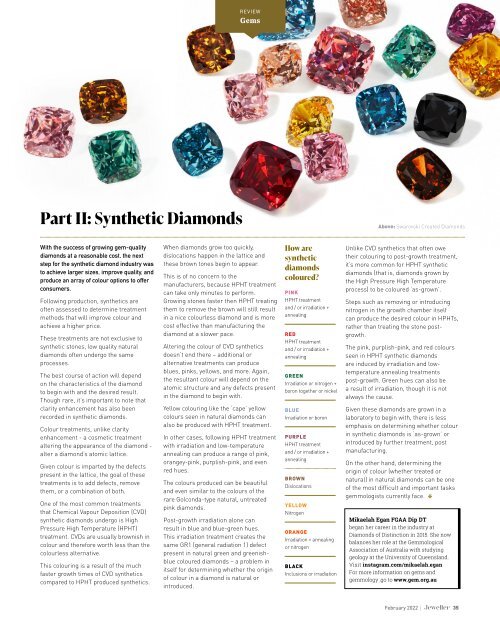Jeweller - February 2022
• Stronger together - Buying Groups get ready for 2022 with newfound vigour • The Great Retail Reset - Pandemic demonstrates that every cloud has a silver lining • Vale Peter Beck - Tribute to a jewellery industry icon
• Stronger together - Buying Groups get ready for 2022 with newfound vigour
• The Great Retail Reset - Pandemic demonstrates that every cloud has a silver lining
• Vale Peter Beck - Tribute to a jewellery industry icon
Create successful ePaper yourself
Turn your PDF publications into a flip-book with our unique Google optimized e-Paper software.
REVIEW<br />
Gems<br />
Part II: Synthetic Diamonds<br />
Above: Swarovski Created Diamonds<br />
With the success of growing gem-quality<br />
diamonds at a reasonable cost, the next<br />
step for the synthetic diamond industry was<br />
to achieve larger sizes, improve quality, and<br />
produce an array of colour options to offer<br />
consumers.<br />
Following production, synthetics are<br />
often assessed to determine treatment<br />
methods that will improve colour and<br />
achieve a higher price.<br />
These treatments are not exclusive to<br />
synthetic stones, low quality natural<br />
diamonds often undergo the same<br />
processes.<br />
The best course of action will depend<br />
on the characteristics of the diamond<br />
to begin with and the desired result.<br />
Though rare, it’s important to note that<br />
clarity enhancement has also been<br />
recorded in synthetic diamonds.<br />
Colour treatments, unlike clarity<br />
enhancement - a cosmetic treatment<br />
altering the appearance of the diamond -<br />
alter a diamond’s atomic lattice.<br />
Given colour is imparted by the defects<br />
present in the lattice, the goal of these<br />
treatments is to add defects, remove<br />
them, or a combination of both.<br />
One of the most common treatments<br />
that Chemical Vapour Deposition (CVD)<br />
synthetic diamonds undergo is High<br />
Pressure High Temperature (HPHT)<br />
treatment. CVDs are usually brownish in<br />
colour and therefore worth less than the<br />
colourless alternative.<br />
This colouring is a result of the much<br />
faster growth times of CVD synthetics<br />
compared to HPHT produced synthetics.<br />
When diamonds grow too quickly,<br />
dislocations happen in the lattice and<br />
these brown tones begin to appear.<br />
This is of no concern to the<br />
manufacturers, because HPHT treatment<br />
can take only minutes to perform.<br />
Growing stones faster then HPHT treating<br />
them to remove the brown will still result<br />
in a nice colourless diamond and is more<br />
cost effective than manufacturing the<br />
diamond at a slower pace.<br />
Altering the colour of CVD synthetics<br />
doesn’t end there – additional or<br />
alternative treatments can produce<br />
blues, pinks, yellows, and more. Again,<br />
the resultant colour will depend on the<br />
atomic structure and any defects present<br />
in the diamond to begin with.<br />
Yellow colouring like the ‘cape’ yellow<br />
colours seen in natural diamonds can<br />
also be produced with HPHT treatment.<br />
In other cases, following HPHT treatment<br />
with irradiation and low-temperature<br />
annealing can produce a range of pink,<br />
orangey-pink, purplish-pink, and even<br />
red hues.<br />
The colours produced can be beautiful<br />
and even similar to the colours of the<br />
rare Golconda-type natural, untreated<br />
pink diamonds.<br />
Post-growth irradiation alone can<br />
result in blue and blue-green hues.<br />
This irradiation treatment creates the<br />
same GR1 (general radiation 1) defect<br />
present in natural green and greenishblue<br />
coloured diamonds – a problem in<br />
itself for determining whether the origin<br />
of colour in a diamond is natural or<br />
introduced.<br />
How are<br />
synthetic<br />
diamonds<br />
coloured?<br />
PINK<br />
HPHT treatment<br />
and / or irradiation +<br />
annealing<br />
RED<br />
HPHT treatment<br />
and / or irradiation +<br />
annealing<br />
GREEN<br />
Irradiation or nitrogen +<br />
boron together or nickel<br />
BLUE<br />
Irradiation or boron<br />
PURPLE<br />
HPHT treatment<br />
and / or irradiation +<br />
annealing<br />
BROWN<br />
Dislocations<br />
YELLOW<br />
Nitrogen<br />
ORANGE<br />
Irradiation + annealing<br />
or nitrogen<br />
BLACK<br />
Inclusions or irradiation<br />
Unlike CVD synthetics that often owe<br />
their colouring to post-growth treatment,<br />
it’s more common for HPHT synthetic<br />
diamonds (that is, diamonds grown by<br />
the High Pressure High Temperature<br />
process) to be coloured ‘as-grown’.<br />
Steps such as removing or introducing<br />
nitrogen in the growth chamber itself<br />
can produce the desired colour in HPHTs,<br />
rather than treating the stone postgrowth.<br />
The pink, purplish-pink, and red colours<br />
seen in HPHT synthetic diamonds<br />
are induced by irradiation and lowtemperature<br />
annealing treatments<br />
post-growth. Green hues can also be<br />
a result of irradiation, though it is not<br />
always the cause.<br />
Given these diamonds are grown in a<br />
laboratory to begin with, there is less<br />
emphasis on determining whether colour<br />
in synthetic diamonds is ‘as-grown’ or<br />
introduced by further treatment, post<br />
manufacturing.<br />
On the other hand, determining the<br />
origin of colour (whether treated or<br />
natural) in natural diamonds can be one<br />
of the most difficult and important tasks<br />
gemmologists currently face.<br />
Mikaelah Egan FGAA Dip DT<br />
began her career in the industry at<br />
Diamonds of Distinction in 2015. She now<br />
balances her role at the Gemmological<br />
Association of Australia with studying<br />
geology at the University of Queensland.<br />
Visit instagram.com/mikaelah.egan<br />
For more information on gems and<br />
gemmology ,go to www.gem.org.au<br />
<strong>February</strong> <strong>2022</strong> | 35


















